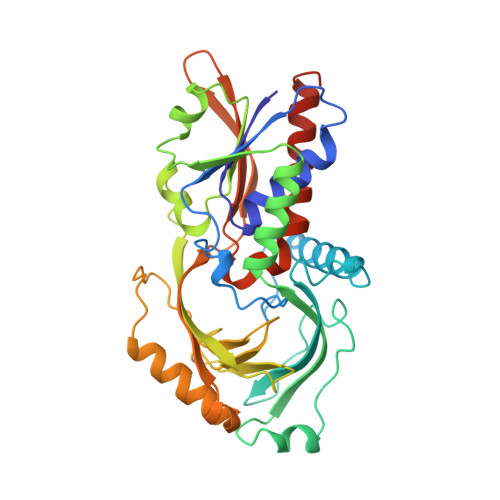Crystal structure of D-amino acid oxidase: a case of active site mirror-image convergent evolution with flavocytochrome b2.
Mattevi, A., Vanoni, M.A., Todone, F., Rizzi, M., Teplyakov, A., Coda, A., Bolognesi, M., Curti, B.(1996) Proc Natl Acad Sci U S A 93: 7496-7501
- PubMed: 8755502
- DOI: https://doi.org/10.1073/pnas.93.15.7496
- Primary Citation of Related Structures:
1KIF - PubMed Abstract:
D-amino acid oxidase is the prototype of the FAD-dependent oxidases. It catalyses the oxidation of D-amino acids to the corresponding alpha-ketoacids. The reducing equivalents are transferred to molecular oxygen with production of hydrogen peroxide. We have solved the crystal structure of the complex of D-amino acid oxidase with benzoate, a competitive inhibitor of the substrate, by single isomorphous replacement and eightfold averaging. Each monomer is formed by two domains with an overall topology similar to that of p-hydroxybenzoate hydroxylase. The benzoate molecule lays parallel to the flavin ring and is held in position by a salt bridge with Arg-283. Analysis of the active site shows that no side chains are properly positioned to act as the postulated base required for the catalytic carboanion mechanism. On the contrary, the benzoate binding mode suggests a direct transfer of the substrate alpha-hydrogen to the flavin during the enzyme reductive half-reaction. The active site Of D-amino acid oxidase exhibits a striking similarity with that of flavocytochrome b2, a structurally unrelated FMN-dependent flavoenzyme. The active site groups (if these two enzymes are in fact superimposable once the mirror-image of the flavocytochrome b2 active site is generated with respect to the flavin plane. Therefore, the catalytic sites of D-amino acid oxidase and flavocytochrome b2 appear to have converged to a highly similar but enantiomeric architecture in order to catalvze similar reactions (oxidation of alpha-amino acids or alpha-hydroxy acids), although with opposite stereochemistry.
Organizational Affiliation:
Dipartimento di Genetica e Microbiologia, Università di Pavia, Italy.
















